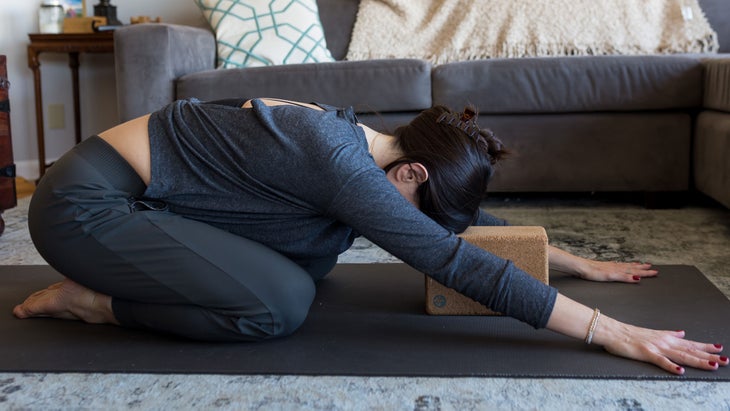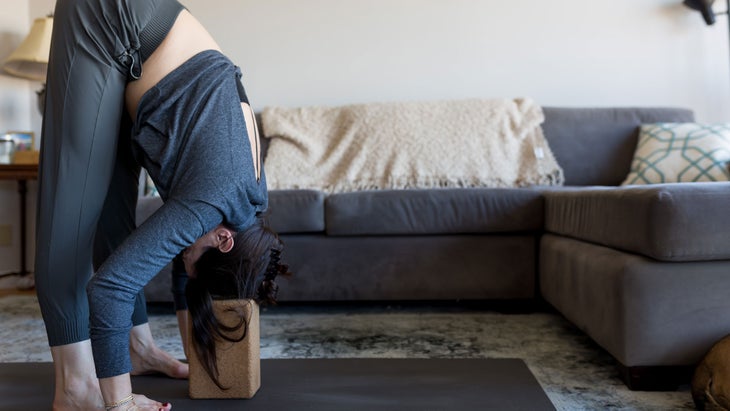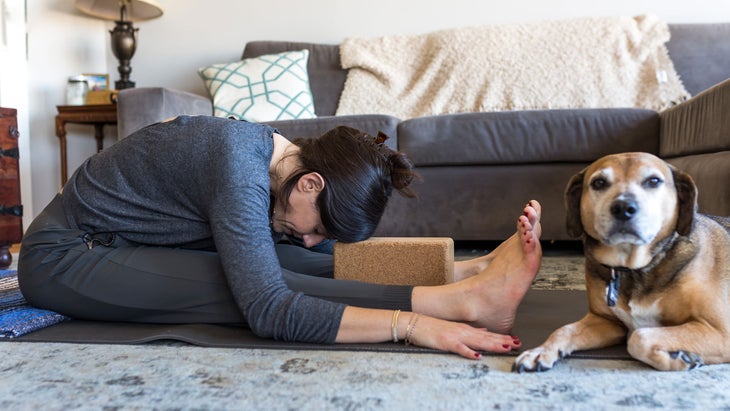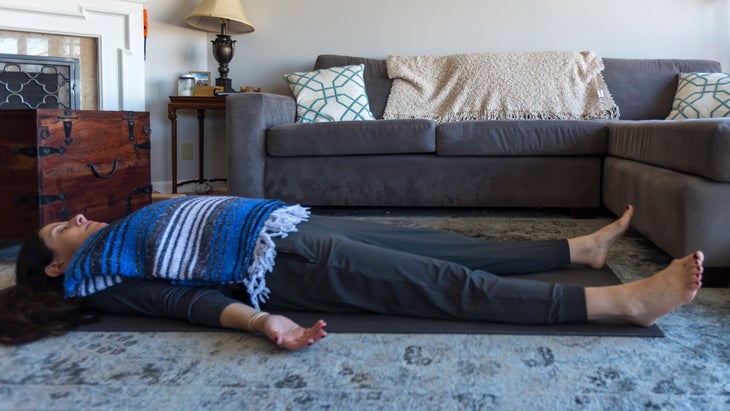Heading out the door? Read this article on the new Outside+ app available now on iOS devices for members! Download the app.
At 27-years-old, I lost my mother to lung cancer. When she was just weeks from passing, and at her worst, a friend tried to comfort me by saying “chin up.” I knew he was trying to help—but literally moving my chin upward was the last thing I (or my body) wanted to do.
When we are in grief, the body naturally wants to cave in. There is a heaviness. As Michelle Obama said of her father’s death in her recent book Becoming, “It hurts to live after someone has died.” If someone you love is near death, it hurts to live before they have died, too.
Yet people frequently offer that type of chin-up advice, encouraging us to “keep our head up” or “hold our head high” when we are going through tough times. Yet is that really what someone who is grieving needs? Or is that someone else’s own discomfort in the face of our sadness? When we suffer loss, people often do not know what to say. What if instead of trying to make each other feel better in the face of loss and deep grief, we gave ourselves permission to hang our heads for a little while?
See also How Yoga Helped One Rape Survivor Cope With the Kavanaugh Hearings
Grief has no guidebook—no straight line to follow. Grief is the soul’s way of mourning a person, place, or thing of time past. It comes in waves and is rarely predictable. One minute you are balled up on the couch crying pools of tears, the next you are laughing, the next you are numb. Because of this, the kindest thing we can do for ourselves when experiencing grief is to allow it to be there and give ourselves time to heal.
In yoga, we practice a lot of sequences that open the heart. Rarely do we hear teachers encourage us to close our hearts. However, after a significant loss, this may be the most healing thing to do. Whenever I have experienced an important death, I can’t even practice the most passive backbends. The body’s desire to curl inward is an evolutionary response to stress and trauma—a way to protect the vital organs.
I have also come to believe that our impulse to fold in when grieving is a way to keep the pieces of the heart together after it breaks.
If all you do is unroll your mat and rest in Child’s Pose today, great. If you feel like moving a bit more, here is a sequence to help you close your heart so it can heal.
See also How to Form a New Relationship with Your Anxiety
A Yoga Sequence for Grief
Balasana (Child’s Pose) Flow

Few poses are as comforting as Child’s Pose. This posture encapsulates what the body organically wants to do when we are under duress: curl in. Come onto your shins with the tops of the feet on the floor. Bring your big toes together and spread your knees apart. Shift your hips back toward your heels and reach your arms in front of you. Rest your forehead on a block to give your brain a rest, too. It is helpful to be on your fingertips to keep space in your neck and shoulders. Stay here as long as you like.
See also 7 Things You Should Do for a Grieving Friend
Sukhasana (Comfortable Pose)

Continue to rest your brain while starting to release your hips. Because the body contracts after trauma, long holds are a gentle way to start to open things back up. Start by sitting on your mat or on a folded blanket. Cross your legs so your right shin is in front of your left, resting your knees on your ankles. Flex your ankles strongly to protect your knees. On an inhalation, reach your arms up to the ceiling; on an exhalation, fold over your legs, resting your forehead on a block or the floor. Stay here for 25 long breaths. Inhale to slowly come up and switch sides.
See also How Yoga Teacher Training Helped Me Find Healing Courage When I Needed it Most
Uttanasana (Standing Forward Fold)

Start to reconnect to your legs—and as a result, your own strength—with this calming and lengthening forward fold. At the back of the mat, step your feet hip-width distance apart and on an exhalation, fold over your legs. If you are able, rest the crown of your head on a block, which can be incredibly restorative. Otherwise, simply let your head hang. Your arms will dangle loosely, palms on the floor or clasp opposite elbows. Hold for 15 breaths. Round your way to standing, very slowly, one vertebra at a time. Let your head be the last thing to come up and stand upright for a few moments before moving on to the next pose.
See also What is Qi Gong?(And How You Can Start Practicing Today)
Parsvottanasana (Pyramid Pose)

Begin standing at the front of your mat in Tadasana. Exhale and step your left foot back about 3 feet. Turn your back foot inward about 45 degrees for stability. (Your feet should be slightly wider than heel to heel.) Place your hands on your hips and on an inhalation, lift your chest; on an exhalation, fold over your legs, putting your hands on blocks or on the floor. If your arms are long enough, you may walk your hands back toward your back foot. Lengthen your torso over your front leg by reaching your chest to the front foot. Stay here for 20 breaths. On an inhalation, come halfway up; on an exhalation, bring your hands to your hips. Inhale all the way up to standing and step your back foot to the top of the mat to repeat on the other side.
See also How to Talk About Tough Stuff in Your Yoga Classes
Janu Sirsasana (Head to Knee Pose)

This simple pose is incredibly comforting because in this pose, you’ll rest upon yourself. Start seated on a blanket with both of your legs straight out in front of you in Dandasana. Bend your right knee and turn your thigh open, pulling your right heel up toward your groin. On an inhalation, reach your arms up to the sky and exhale fold over the left thigh. You may grab an opposite wrist (in this case, right hand hold left wrist) or simply bend your elbows on the floor. Disregard the name of the pose and instead of trying to touch your head to your knee, which can lead to over-rounding, think of reaching the top of your head to your foot. Stay here for 30 breaths and on an inhalation, come up to sit. Stretch your right leg out and pause before switching sides.
See also 3 Things I Learned After Taking a Break from My Yoga Practice
Restorative Pascimottanasana (Western Stretch)

Go even further inward with this back-body lengthener. This pose not only releases your back thighs, but also your postural muscles, which work so hard to keep our head up when we are in grief or suffering. Sitting in Dandasana on your mat or a folded blanket, separate your legs as wide as your hips. Place a block between your legs, closer to your shins. On an inhalation, reach your arms up; on an exhalation, fold over both legs. Flip the block as high as it needs to be in order to rest your forehead on it. Your arms can rest by your sides with your elbows bent, which releases the muscles of your upper back, or you may reach to grab your feet. Take 30 breaths here before slowly inhaling to come up with a long spine.
See also 6 Yoga Retreats to Help You Recover from a Bad Breakup
Corpse Pose (Savasana), variation

Savasana is quite a vulnerable shape in the best of times, so we will use a blanket to continue the feeling of being protected while gently opening the body (and ourselves) back up to the outer world. You can use as light or as heavy a blanket as feels comfortable. Lay on your back and separate your legs slightly wider than your hips, allowing your thighs to roll open. Place a folded blanket over your chest and belly, with the top of the blanket at the height of your shoulders. Let your arms rest by your sides and turn your palms so they face upward. Let this be a symbol of starting to take in the energy of the outside world. Rest the back of your head against the mat and keep your eyes closed and brain heavy. Stay here for 7 to 10 minutes. When it is time to come out, move very slowly. Let this symbolize how gentle you will be with yourself during this delicate time. On an inhalation, raise your arms overhead, bend your knees, and roll to your right side. Stay here in the fetal position for a minute or longer, then press into the floor with your left hand and come up to sit on an inhalation. Your head should be the last thing to rise. Sit quietly with yourself for a few minutes, simply allowing any and all emotions to arrive.
See also How to Step Into Your Feminine Power with the Wisdom of the Dakinis